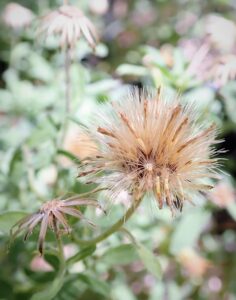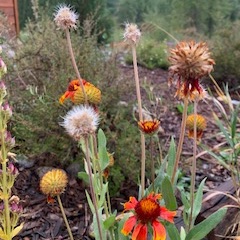Colorado native plants evolved in tough soils and climates. Even in natural areas with no supplemental water many are producing fertile seeds this year. Prior to collecting, it’s a good idea to review the Colorado Native Plant Society’s collection protocols.
Front Range Wild Ones follows ethical seed collection protocols. In fact, we are a little more conservative than the general 20% collection rate. We aim for 10-15% in natural spaces only from healthy, plentiful species populations. This is one of the reasons land stewards allow us to collect. In 2024, wild and natural spaces had lower-than normal blooms for many species. Some of our typical spaces have canceled collections or are limiting only to certain, plentiful, populations. Of course, always get permission to collect from any landscape that you do not own, and collect only 10-20% or less of any seeds to allow for the seed bank to be replenished.
If collecting seeds in legitimate areas and your gardens has slipped your mind, it is time to get cracking and get ready to swap seeds at the WOFR/PPAN fall Native Seed Swap in Denver and in Colorado Springs this November– view all of our upcoming Native Plant & Seed Swaps in our Events Calendar.

How to collect native seeds
You will need paper bags and/or small re-sealable plastic bags and a pair of clippers or scissors. Look for fruits that are turning brown or fluffy. Some will split at a seam (or two) or gape open at the tip. Some may have holes like those of a salt shaker. Aster family plants have seed heads that get poufy (think dandelion) when they are ripe. This is a large family that includes aster, goldenrod, gayfeather or blazing star, daisies, black-eyed-Susan, coneflowers and even thistles (yes, there are many native thistles). If you can monitor collection time, collect when you can easily pluck the seeds from the receptacle and do not have to cut the entire head. If you do clip heads into the paper bag, let the collection sit for about a week to continue ripening and drying. Many seeds should fall into the bag naturally.
A caution about aster family plants. If you are collecting in a garden, you need more than one seed-grown plant to produce fertile seeds. And if you have more than one plant but they are all clonal, i.e., grown from vegetative cuttings, they cannot produce fertile seeds. Plants with a cultivar name may or may not produce fertile seeds. For instance, the grass ‘Blond Ambition’ will only produce fertile seeds if there are other Blue Grama (Bouteloua gracilis) plants in the area. The resulting seedlings may or may not have the special characteristics of “Blond Ambition.’ Other fruit arrangements such as the spikes of penstemon capsules encourage clipping all or part of the spike and inverting it into the bag. If the capsule has not opened at the top, you may need to crush the woody capsule with a rolling pin.
To collect grass seeds, run your hand along the entire inflorescence and put the handful of seeds into the bag.
How to store and clean native seeds

Seeds can sit in the bags for a fair amount of time unless you have noticed weevil holes in the fruit (often a problem with legumes). Any fruits/seeds with critters should be cleaned promptly and put in the freezer for two weeks. Be sure they are thoroughly dried before freezing.
To start the cleaning process, use sieves with various hole sizes to clean the seeds. Kitchen colanders and strainers work well. Proper soil sieves are great because they are sturdy and you can rub the seeds vigorously against the screen. Once you have only chaff remaining, you can use a hair dryer on low heat and air flow to blow away the chaff (you will want to run an extension cord outdoors to do this). Hold the hair dryer at arm’s length below the sieve and gradually move it closer while you gently move the sieve with the other hand. If the seeds are very small they will fly away with the chaff so experiment with the hair dryer slowly. Remove as much extraneous vegetative material as you can; cleaning seeds by hand defies perfection.
Place the cleaned seeds into containers that can be stored in a refrigerator. Coin envelopes can be organized into a plastic or glass storage container, which will occupy minimal space. Paper allows you to write the species name, collection date and location and elevation on the envelope.
How to label native seeds
Ideally, you want to label seed packets or containers with the scientific name (Genus, species), collection date, location and approximate elevation. If you are unsure of the species name, put a common name on the envelope. Take pictures of the plant focusing on the entire plant, the flower or fruit and the leaf and the leaf attachment. Volunteers at the Seed Swap may be able to help identify your plant. We want the Native Seed Swap to be fun and educational.
by Jan Midgley
